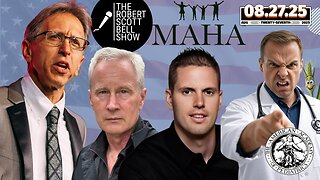Premium Only Content

Dogs - Samson And Cheerio: The All American Bullies (AKA Not Pitbulls).
The All American Bullies - Samson and Cheerio love playing tug-of-war with branches, and eating them. They get very aggressive but they are so loving towards everyone including cats. The are Pure Bred and come from the Anarchy Line. American Bullies (AKA Pitbulls) have gotten a bad rap!
Would it surprise you to learn that pit bulls used to be America’s darlings? Before the mid-80s, stories of pit bull attacks are practically non-existent. There is even some confusion over exactly which breed of dog is a pit bull — the definition includes the American pit bull terrier, the Staffordshire terrier and, at times, the bulldog. This confusion seems to have dogged the breed from the beginning, as there is some disagreement over the origin of pit bulls.
Where do pit bulls come from and how did they get such a bad rap?
Two possible histories of pit bulls:
In one theory, pit bulls began during antiquity as the so-called Molossus, a now-extinct breed that was used by the Greeks as shepherds and guard dogs. In times of war, they marched off to battle with their humans. Eventually, so the theory goes, the Molossus made it to early Britain, where it became known as the Mastiff. In the first century CE, Rome discovered the breed after defeating the Britons, and the dogs spread all over the empire. For the next four hundred years, they were used as war dogs, and intermixed with various local breeds all over the European continent, becoming the forerunners of the modern pit bull.
A competing theory places the origin of the pit bull in England at the time of the Norman Conquest in 1066, when butchers would use large, Mastiff-type dogs as “bullenbeissers,” which translates as “bull biter.” Trained to latch onto a bull’s nose and not let go until the animal was subdued, these dogs were the only way that humans could regain control when a bull became agitated. Unfortunately, this practical if dubious use eventually led to the “sport” of bull-baiting, where dogs were put in a pit with an intentionally riled-up bull and spectators placed bets on which dog would hold on the longest, or bring the bull down. You’ve probably guessed it by now, but this is also the origin of the terms “pit bull dog” and “bulldog.”
Still not a specific breed, the bullenbeissers were bred with Terriers, combining their intelligence with the strength of the Mastiffs. As bull-baiting came to be banned in the 19th century, dog fighting became popular as an underground and quasi-illegal activity in the UK. British immigrants to the U.S. at that time brought dog fighting, as well as their dogs, to the New World. However, as the breed spread to Americans and Americans spread across the continent, pit bulls began to be put to their original use, as general purpose herding and working dogs. Because of their fighting history, though, the American Kennel Club would not recognize the breed until 1936, although they defined it as a Staffordshire terrier, distinct from the American pit bull terrier.
Early perceptions of pit bulls:
Far from being considered a killing machine on legs, pit bulls seem to be an American favorite in the early half of the century — indeed, during World War I, the country itself is personified as a pit bull on army recruitment posters, and several pit bulls go on to become famous in the American military. Referring to an athlete as a pit bull is a very common sports metaphor through the 1930s, and it is meant as the highest compliment. There is also a famous racehorse in the late 1930s named Pit Bull, as well as a number of pit bull stars of early motion pictures. Frequently, pit bulls are associated with children, as in the Our Gang comedies, as well as with Buster Brown, both in short films and as the corporate mascot for a shoe company. The famous RCA Victor image of a dog and a gramophone also featured a pit bull terrier.
From the turn of the century until the early 1980s, there is exactly one dog attack story to make the national papers and mention pit bulls, but that’s probably because it involved a man intentionally siccing a pack of 26 dogs on a young woman. According to a 1947 article in The Independent (St. Petersburg, Florida), “Attorneys said they believed it was the first time the state had invoked a statute which would find the owner guilty of manslaughter if it were proven that he permitted vicious animals to run free and they attacked and killed a human being.” There’s no mention of pit bulls as vicious and no call for a ban of the breed, just a human who is held responsible for inducing the dogs to attack. Ironically, though, it is in Florida forty years after this incident that the first breed-specific ban is enacted. In the intervening decades, “pit bull” continues to be a popular description for athletes and when the breed does turn up in newspapers, it’s more often than not in a classified ad for puppies.
Got Pain? https://thehealthplace.net/
-
 LIVE
LIVE
Kim Iversen
2 hours agoNetanyahu Says Armenian Genocide Was Real — But Gaza Deaths Are A “Mishap"
1,815 watching -
 LIVE
LIVE
vivafrei
1 hour agoAnother "Trans" Mass Shooter? Rampage Jackson Keeps Digging? Democrats are Just Awful AND MORE!
2,041 watching -
 1:34:24
1:34:24
Redacted News
1 hour agoLIVE: Minnesota School Shooter’s Shocking Motive Revealed – Plus Trump Targets Soros w AG Ken Paxton
101K50 -
 DVR
DVR
StoneMountain64
4 hours agoHUNTING FOR THE FIRST WIN BACK ON WARZONE
45.5K1 -

The Officer Tatum
2 hours agoBREAKING: Shooter IDENTIFIED TR*NS , Cracker Barrel CAVES To Pressure + MORE | EP 162
23K26 -
 53:47
53:47
Matt Kohrs
2 hours agoLIVE! Nvidia Earnings Call || NVDA Stock Reaction
18K1 -
 LIVE
LIVE
Tudor Dixon
1 hour agoKarol Markowicz on Freedom, Immigration, and Saving the American Dream | The Tudor Dixon Podcast
53 watching -
 2:03:25
2:03:25
The Quartering
4 hours agoFlag Burning, Free Speech, Church Attack & More With Andrew Wilson
187K277 -
 LIVE
LIVE
The Robert Scott Bell Show
19 hours agoDr. Peter McCullough, Vaccines: Mythology, Ideology, and Reality, Dr. Dan Sullivan, Chiropractic - The RSB Show 8-27-25
160 watching -
 1:21:03
1:21:03
Darkhorse Podcast
4 hours agoFreedom, Tyranny, and Childhood Lost: The 291st Evolutionary Lens w/ Bret Weinstein & Heather Heying
34.2K14